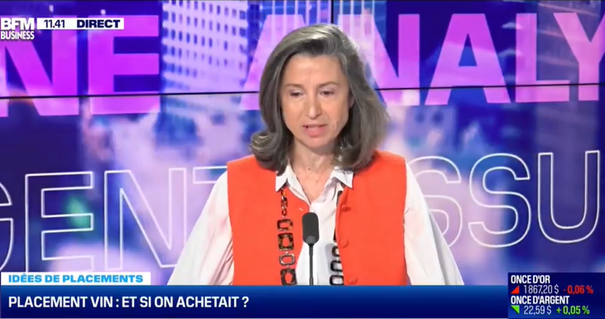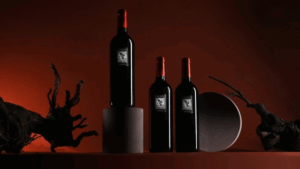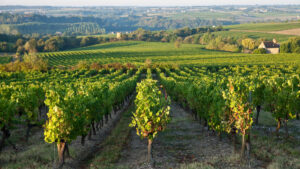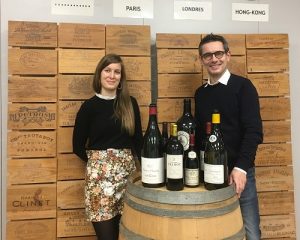
Every Spring, Bordeaux estates sell the wine from their latest vintage ‘en primeur’, a chance to buy and invest in the region’s grands crus. Angélique de Lencquesaing was invited onto BFM’s Business programme to talk about the 2021 vintage campaign.
Could you tell us about how this kind of sale works?
It’s an unusual kind of purchase, since buyers are spending their money on a ‘future’ product. The wine on the market comes from the most recent harvest, in this case the harvest that took place in 2021. The product isn’t ‘ready’ in that the wine hasn’t yet finished its maturing process in the cask. So this means the buyer will get their wine once it has been aged, in one or two years’ time depending on the property’s maturing method.
So it’s not like the Beaujolais nouveau, for example?
No, this is a different system. And the wines sold en primeur are from some of Bordeaux’s most prestigious properties.
The interest of buying en primeur depends on the quality of the vintage, though?
Yes, absolutely. The quality of a wine depends on three main factors:
The terroir it comes from, the weather conditions throughout the year, and the choices made by the wine maker at different stages of cultivation and vinification.
Some years, the climate conditions are ideal, which makes the work of the wine maker somewhat easier. Clearly, this wasn’t the case in 2021.
We all remember the dramatic frost that hit vineyards across the country…
Yes, but that wasn’t the only damaging factor.
Is global warming to blame here, too?
Yes and no for the 2021 vintage. Since we had a mild winter, the vines budded earlier than unusual. This meant that the frost did some terrible damage on the 7th and 8th of April last year. As well as this, some wine makers had to cope with poorly-timed episodes of rain that brought about diseases like mildew in the vineyard. The summer was unusually cool, too.
The elements went against their usual nature for most of the year, then?
Fortunately, conditions at the end of the season saved the day, particularly on terroirs planted with Cabernet Sauvignon and Cabernet Franc. The grapes that were harvested a bit later in the season enjoyed a sunny spell that helped them to ripen.
Wine lovers will have to be selective in their 2021 choices then?
Yes, 2021 hasn’t been a vintage bursting with successes; rather, we might call it a ‘vintner’ vintage, one that has called for some real hard work and humility. A terroir vintage as well, since the better exposed ones have come out it better.
Have the Primeurs tasting sessions confirmed the success of any particular properties?
The tasting sessions had some surprises in store, particularly for blends that lean heavily on Cabernet grapes. The 2021 vintage has turned out to be quite a fresh and elegant one, without too much power, alcohol, or extraction. Some of them have a delicate character, singling them out as bottles that could be uncorked in their youth.
What are the advantages of buying en primeur?
There are three main advantages to buying during the Bordeaux campaign. Firstly, you’ll have your hands on the bottles as soon as they leave the château’s winery, meaning that you can pick the exact place the wine will wait before being uncorked. This avoids too many intermediaries.
The second advantage is all the more pertinent for a vintage of tricky weather conditions: the buyer has first dibs on the bottles from producers they love, some of which might become very rare.
Third is the price, which is the founding idea behind the Primeurs campaign. By selling their wines for attractive prices at this stage, the châteaux can afford to keep going whilst their wines mature. But this detail is always a mystery before the estate launches its official campaign for the year.
If you’re buying en primeur to invest, the price will determine your choices, right?
Yes, that’s right. And with the vintage’s character in mind, the price is the missing puzzle piece until the year’s campaign is underway. The quality of the wine, established by professional tasters in the weeks leading up to the Primeurs, sends a signal to the market, giving consumers an idea of what kind profile the cuvées have, and when they will perhaps be best enjoyed.
The financial aspect of the campaign is clearly the other key when investing. As long as the Primeurs price of a wine is attractive, the wine can be considered an investment. Beyond its intrinsic qualities, the value of the wine will then be likely to grow within a few years.
How long does it take for the value of one of these wines to increase?
Tariffs have increased over the years, extending the time required for a return on investment. Nowadays, you’d expect to age a Bordeaux grand cru for 8 to 10 years to see a worthwhile increase in value. This is why most of the Bordeaux bottles we sold at auction last year were mature; 85% were over 10 years old. This kind of wine is a mid-term investment.



